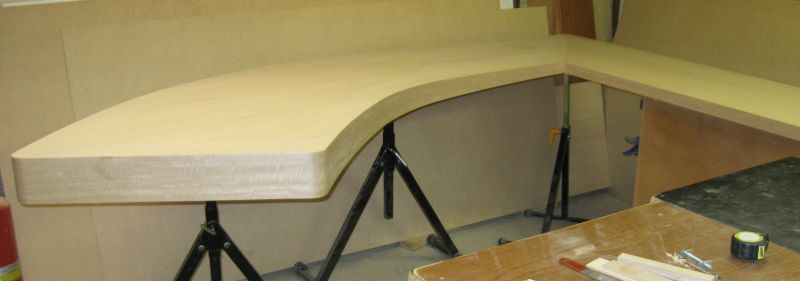Question
The edges in the curved desk below taper in thickness. I used solvent based contact cement - two coats on the substrate (particle board - kerfboard), and one coat on the 10 mil paperback anigre veneer. It was applied with wood scraper and hammer and block. It stayed flat and beautiful on the curved surfaces as well as the radius corners. It was beautiful for six weeks, then it went to the finishing room for pre-catalized lacquer sealer and wiping stain then pre-cat topcoat.
I just noticed the veneer on the edges is checking, small checks as well as along one of the joints between flitches. This veneer was purchased on a 10 mil backer. Itís not all checking, just on the inside curve and the flat end, and around the radius corners very small checks. I may have too heavy of a coat of lacquer on it. Will that cause the glue to soften and allow the veneer to check?
I don't trust it now and want to remove it and the glue. Then use FSV glue on the edge with clamps and kerf board to press it. I don't see how a vacuum bag would work without crinkling the veneer on the curves as it would be cut oversize and veneer won't bend in two directions at the same time. Thus the bag would bend the top and bottom edges of veneer over onto the surface of the desk and screw it up? Am I wrong in this thinking?

Forum Responses
(Veneer Forum)
From contributor J:
I know you've read it here before - contact cement is never a good adhesive choice for veneer. It is just too flexible. Not sure about the FSV, I don't have any experience with it. I would make curved cauls and press it with cold press glue, or use solid anigre for the edges. Another thing I've done with success for curves is to press the veneer on 1/8" bending ply flat in the bag. Then you can sand it while itís flat, then apply it to your kerfcore backer or a lamination of other bending ply. It works great.
Anyway now I need to remove the veneer on the edge and get all the glue off before I can use the FSV glue. Itís a high tack, fast setting cold press glue from Custom Bond. It worked well on the inlay doors for this project. It claims a semi rigid glue line to hold the veneer tight. Its advantage is fast set and limited press time. My question now is can I get all the contact cement off to allow the glue to bond to the wood edging? It won't be fun getting the glue off - any tricks you know of?